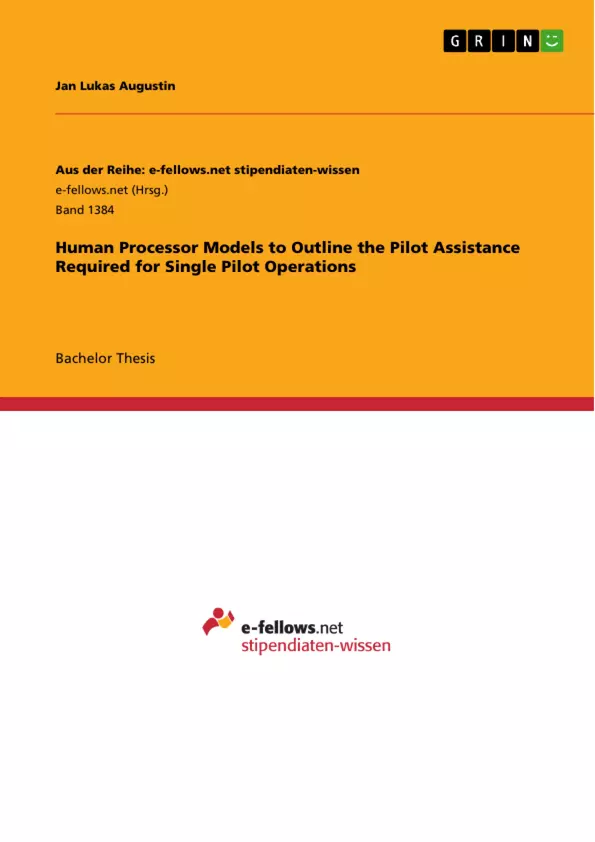The object of this thesis is to outline prospective assistance systems enabling a pilot to fly an airliner single-handedly. A cognitive modelling technique called Model Human Processor is introduced. Procedures and tasks involved in the operation of an aircraft are identified. Assumptions with respect to the single pilot design alternative are made. A simulation is implemented in Matlab in order to assess the pilots’ workload. Results allow for a procedure time and workload comparison of the two flight crew alternatives. The outcome of this analysis facilitates the design of potential additional pilot support systems that can reduce workload and improve situational awareness.
Inhaltsverzeichnis (Table of Contents)
- Abstract
- Table of contents
- Nomenclature
- 1 Introduction
- 2 State of research
- 2.1 Human-factors engineering
- 2.2 Flight phases
- 2.3 Cockpit systems
- 2.4 Operating procedures
- 3 Model Human Processor
- 3.1 Perceptual System
- 3.1.1 Perceptual Memories
- 3.1.2 Perceptual Processor
- 3.2 Motor System
- 3.2.1 Motor Processor
- 3.3 Cognitive System
- 3.3.1 Cognitive Memories
- 3.3.2 Working Memory
- 3.3.3 Long-Term Memory
- 3.3.4 Cognitive Processor
- 3.4 Movement - Fitt's Law
- 3.1 Perceptual System
- 4 Model
- 4.1 Structure
- 4.1.1 Definitions
- 4.2 Model design
- 4.2.1 Assumptions
- 4.2.2 Identifying procedures, tasks and actions
- 4.2.3 Representation in spreadsheet
- 4.3 Simulation
- 4.3.1 Structure
- 4.3.2 Import
- 4.3.3 Sums of imported values
- 4.3.4 Distributions
- 4.3.5 Movement Fitt's Law
- 4.3.6 Procedure times
- 4.4 Results
- 4.4.1 Total action times
- 4.4.2 Procedure times for exemplary flight sectors
- 4.4.3 Workload of Pilot Flying
- 4.5 Validation
- 4.1 Structure
- 5 Pilot assistance
- 5.1 Interfaces
- 5.1.1 Control panels
- 5.1.2 Microphone
- 5.1.3 Touch screen
- 5.1.4 Loudspeaker
- 5.1.5 Head up display
- 5.1.6 Eye tracker
- 5.2 System outline
- 5.2.1 Cross checks
- 5.2.2 Check lists
- 5.3 Information design
- 5.3.1 Perceptual System
- 5.3.2 Cognitive System
- 5.3.3 Conclusion
- 5.4 Simultaneousness
- 5.4.1 Input
- 5.4.2 Output
- 5.5 Limitations
- 5.1 Interfaces
- 6 Conclusion
- References
- List of figures
- List of tables
- 7 Appendix
- 7.1 Model Human Processor
- 7.2 Procedure representation
- 7.3 Matlab Code
- 7.4 Distributions
- 7.5 Results
Zielsetzung und Themenschwerpunkte (Objectives and Key Themes)
This thesis aims to investigate the feasibility of single pilot operations in airliners by exploring the potential for assistance systems to reduce pilot workload. The study utilizes the Model Human Processor (MHP) cognitive modelling technique to analyze the cognitive demands of flight operations. * **Model Human Processor:** The thesis explores the application of the MHP framework to model pilot workload and identify areas for potential assistance. * **Single Pilot Operations:** The research investigates the feasibility and potential challenges of single pilot operations in airliners. * **Pilot Workload:** The study examines the workload imposed on pilots during flight operations and seeks to identify areas for workload reduction. * **Pilot Assistance Systems:** The research explores the design and implementation of assistance systems that can enhance pilot performance and reduce workload. * **Cognitive Modeling:** The thesis utilizes cognitive modeling techniques to understand the cognitive processes involved in flight operations and to inform the design of assistance systems.Zusammenfassung der Kapitel (Chapter Summaries)
- Chapter 1: Introduction This chapter provides an overview of the research topic, outlining the motivation for studying single pilot operations and the importance of pilot workload reduction. It introduces the Model Human Processor (MHP) as a key tool for analyzing cognitive demands and identifying potential assistance systems.
- Chapter 2: State of Research This chapter reviews existing research on human-factors engineering, flight phases, cockpit systems, and operating procedures. It provides a context for the study by highlighting relevant findings and areas of ongoing research.
- Chapter 3: Model Human Processor This chapter presents a detailed description of the Model Human Processor (MHP) framework, outlining its components (perceptual, motor, and cognitive systems) and their functions. It also discusses the application of Fitt's Law to model movement times within the MHP framework.
- Chapter 4: Model This chapter outlines the model used in the thesis, including the structure, design, and implementation of a simulation in MATLAB. It describes the assumptions made, the identification of procedures, tasks, and actions, and the representation of these elements in a spreadsheet. The chapter also presents the results of the simulation, including total action times, procedure times for exemplary flight sectors, and the workload of the pilot flying.
- Chapter 5: Pilot Assistance This chapter explores potential pilot assistance systems, focusing on interface design, system outline, information design, and the concept of simultaneousness. It discusses the limitations of current technology and the need for further research and development.
Schlüsselwörter (Keywords)
The primary focus of this research is the application of the Model Human Processor (MHP) to analyze pilot workload in the context of single pilot operations. Key themes include the cognitive demands of flight operations, the feasibility of single pilot operations, the design of pilot assistance systems, and the role of cognitive modeling in aviation safety. The research draws on concepts from human-factors engineering, cognitive psychology, and aviation ergonomics.- Quote paper
- Jan Lukas Augustin (Author), 2015, Human Processor Models to Outline the Pilot Assistance Required for Single Pilot Operations, Munich, GRIN Verlag, https://www.grin.com/document/300264



